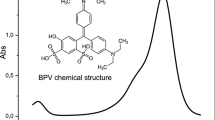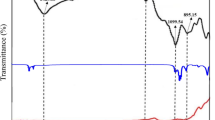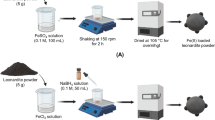Abstract
This study presented the efficient removal of tartrazine, a typical biorefractory dye, in a heterogeneous photochemical Fenton-like system adopting Fe0 and oxalate (Ox) (UV/Fe0/Ox). Only 47.4% tartrazine could be removed within 60 min with a UV/Fe0 system. The addition of Ox could significantly enhance the removal of tartrazine to 72.4% within only 20 min with the UV/Fe0/Ox system. The effects of various factors, such as the Fe0 dose (0–0.8 g/L), Ox dose (0–2 mM), initial pH (2–6), and initial tartrazine concentration (2–30 mg/L), on the removal of tartrazine were examined. Scanning electron microscopy (SEM), Fourier transform infrared (FTIR) spectroscopy, and Mossbauer spectroscopy were conducted to explore the mechanism by which oxalate enhances the performance of the UV/Fe0 system. Ox could inhibit the formation of iron (hydro)xides on the Fe0 surface, thus guaranteeing the reactivity of Fe0 during the reaction. Compared with Fe2O3, FeS, and Fe3O4, Fe0 was a good heterogeneous iron catalyst for the photolysis of tartrazine with the Ox system. Compared with H3PO4, nitrilotriacetic acid, and ethylenediaminetetraacetic acid, Ox was also a good photolysis chelating agent. The UV/Fe0/Ox system could also maintain fast tartrazine removal after five consecutive runs without the addition of Fe0, indicating the good stability of Fe0.









Similar content being viewed by others
Data Availability
Not applicable.
References
Bennet, J., Tholkappiyan, R., Vishista, K., Jaya, N. V., & Hamed, F. (2016). Attestation in self-propagating combustion approach of spinel AFe2O4 (A = Co, Mg and Mn) complexes bearing mixed oxidation states: Magnetostructural properties. Applied Surface Science, 383, 113–125.
Chen, R. P., Cai, J. L., Li, Q., Wei, X. Y., Min, H. H., & Yong, Q. (2020). Coadsorption behaviors and mechanisms of Pb(ii) and methylene blue onto a biodegradable multi-functional adsorbent with temperature-tunable selectivity. RSC Advances, 10, 35636–35645.
Chong, S., Zhang, G., Tian, H., & Zhao, H. (2016). Rapid degradation of dyes in water by magnetic Fe(0)/Fe3O4/graphene composites. Journal of Environmental Sciences, 44, 148–157.
Dai, H. W., Xu, S. Y., Chen, J. X., Miao, X. Z., & Zhu, J. X. (2018). Oxalate enhanced degradation of Orange II in heterogeneous UV-Fenton system catalyzed by Fe3O4 @γ-Fe2O3 composite. Chemosphere, 199, 147–153.
Guan, X., Jiang, X., Qiao, J., & Zhou, G. (2015). Decomplexation and subsequent reductive removal of EDTA-chelated CuII by zero-valent iron coupled with a weak magnetic field: Performances and mechanisms. Journal of Hazardous Materials, 300, 688–694.
Guo, H., Li, Z., Zhang, Y., Jiang, N., Wang, H. J., & Li, J. (2020). Degradation of chloramphenicol by pulsed discharge plasma with heterogeneous Fenton process using Fe3O4 nanocomposites. Separation and Purification Technology, 253, 117540.
Guo, H., Li, Z., Lin, S. Y., Li, D. S., Jiang, N., Wang, H. J., Han, J. G., & Li, J. (2021). Multi-catalysis induced by pulsed discharge plasma coupled with graphene-Fe3O4 nanocomposites for efficient removal of ofloxacin in water: Mechanism, degradation pathway and potential toxicity. Chemosphere, 265, 129089.
Huang, M., Zhou, T., Wu, X., & Mao, J. (2017). Distinguishing homogeneous-heterogeneous degradation of norfloxacin in a photochemical Fenton-like system (Fe3O4/UV/oxalate) and the interfacial reaction mechanism. Water Research, 119, 47–56.
Jiang, B., Xin, S., He, H., Liu, X., Gao, L., Tang, Y., & Bi, X. (2017). Evaluation of the photooxidation efficiency of As(III) applying the UVC/Oxalate technique. Chemosphere, 182, 356–363.
Jiang, H., Zhu, C. Q., Yuan, Y., Yue, C. L., Ling, C., Liu, F. Q., & Li, A. M. (2020). Enhanced activation of peroxymonosulfate with metal-substituted hollow MxCo3-xS4 polyhedrons for superfast degradation of sulfamethazine. Chemical Engineering Journal, 384, 123302.
Lan, Q., Li, F. B., Sun, C. X., Liu, C. S., & Li, X. Z. (2010). Heterogeneous photodegradation of pentachlorophenol and iron cycling with goethite, hematite and oxalate under UVA illumination. Journal of Hazardous Materials, 174, 64–70.
Lan, Q., Cao, M., Ye, Z., Zhu, J., Chen, M., Chen, X., & Liu, C. (2016). Effect of oxalate and pH on photodegradation of pentachlorophenol in heterogeneous irradiated maghemite system. Journal of Photochemistry and Photobiology A: Chemistry, 328, 198–206.
Li, X., Zhou, M. H., & Pan, Y. W. (2018a). Enhanced degradation of 2,4-dichlorophenoxyacetic acid by premagnetization Fe-C activated persulfate: Influential factors, mechanism and degradation pathway. Journal of Hazardous Materials, 353, 454–465.
Li, X., Zhou, M. H., & Pan, Y. W. (2018b). Enhanced degradation of 2,4-dichlorophenoxyacetic acid by premagnetization Fe-C activated persulfate: Influential factors, mechanism and degradation pathway. Journal of Hazardous Materials, 353, 454–465.
Li, J., Li, Y. J., Xiong, Z. K., Yao, G., & Lai, B. (2019). The electrochemical advanced oxidation processes coupling of oxidants for organic pollutants degradation: A mini-review, Chinese Chem. Lett., 30, 2139–2146.
Li, X., Jia, Y., Zhou, M. H., Su, X. F., & Sun, J. H. (2020a). High-efficiency degradation of organic pollutants with Fe, N co-doped biochar catalysts via persulfate activation. Journal of Hazardous Materials, 397, 122764.
Li, J. F., Liu, H. J., Lan, H. C., Ji, Q. H., An, X. Q., Liu, R. P., & Qu, J. H. (2020b). A promising treatment method for Cr(VI) detoxification and recovery by coupling Fe0/Fe3C/C fine powders and circulating fluidized bed. Chemical Engineering Journal, 398, 125565.
Pan, Y. W., Zhou, M. H., Li, X., Xu, L. T., Tang, Z. X., & Liu, M. M. (2016). Novel Fenton-like process (pre-magnetized Fe0/H2O2) for efficient degradation of organic pollutants. Separation and Purification Technology, 169, 83–92.
Pan, Y. W., Zhou, M. H., Cai, J. J., Tian, Y. S., & Zhang, Y. (2019). Mechanism study of nitrilotriacetic acid-modified premagnetized Fe0/H2O2 for removing sulfamethazine. Chemical Engineering Journal, 374, 1180–1190.
Pan, Y. W., Wang, Q., Zhou, M. H., & Cai, J. J. (2020a). Tian Y.S., Zhang Y., Kinetic and mechanism study of UV/pre-magnetized-Fe0/oxalate for removing sulfamethazine. Journal of Hazardous Materials, 398, 122931.
Pan, Y. W., Zhou, M. H., Wang, Q., Cai, J. J., Tian, Y. S., & Zhang, Y. (2020b). EDTA, oxalate, and phosphate ions enhanced reactive oxygen species generation and sulfamethazine removal by zero-valent iron. Journal of Hazardous Materials, 391, 122210.
Repo, E., Koivula, R., Harjula, R., & Sillanpää, M. (2013). Effect of EDTA and some other interfering species on the adsorption of Co(II) by EDTA-modified chitosan. Desalination, 321, 93–102.
Song, K., Mohseni, M., & Taghipour, F. (2019). Mechanisms investigation on bacterial inactivation through combinations of UV wavelengths. Water Research, 163, 114875.
Wang, J. L., & Chen, H. (2020). Catalytic ozonation for water and wastewater treatment: Recent advances and perspective. Science of The Total Environment, 704, 135249.
Xu, L. J., Qi, L. Y., Sun, Y., Gong, H., Chen, Y. L., Pei, C., & Gan, L. (2020a). Mechanistic studies on peroxymonosulfate activation by g-C3N4 under visible light for enhanced oxidation of light-inert dimethyl phthalate. Chinese Journal of Catalysis, 41, 322–332.
Xu, L. J., Zhang, X. M., Han, J. G., Gong, H., Meng, L., Mei, X., Sun, Y., QiL, Y., & Gan, L. (2020b). Degradation of emerging contaminants by sono-Fenton process with in situ generated H2O2 and the improvement by P25-mediated visible light irradiation. Journal of Hazardous Materials, 391, 122229.
Zhang, C., Ren, G. B., Wang, W., Yu, X. M., Yu, F. K., Zhang, Q. Z., & Zhou, M. H. (2019a). A new type of continuous-flow heterogeneous electro-Fenton reactor for tartrazine degradation. Separation and Purification Technology, 208, 76–82.
Zhang, H., Ji, Q. Q., Lai, L. D., Yao, G., & Lai, B. (2019b). Degradation of p-nitrophenol (PNP) in aqueous solution by mFe/Cu-air-PS system, Chinese Chem. Lett., 30, 1129–1132.
Zhou, T., Wu, X., Mao, J., Zhang, Y., & Lim, T. T. (2014). Rapid degradation of sulfonamides in a novel heterogeneous sonophotochemical magnetite-catalyzed Fenton-like (US/UV/Fe3O4/oxalate) system. Applied Catalysis B: Environmental, 160-161, 325–334.
Funding
This study was financially supported by the National Key Research and Development Project (2017YFC0505803) and the National Natural Science Foundation of China (No. 41977354). This study was also financially supported by the Priority Academic Program Development of Jiangsu Higher Education Institutions (PAPD).
Author information
Authors and Affiliations
Contributions
Yuwei Pan: Conceptualization, methodology, formal analysis, investigation, data curation, writing original draft, and writing review and editing. Zhuoyu Bu: investigation and resources. Xiang Li: investigation and resources. Jiangang Han: supervision, funding acquisition, and resources.
Corresponding authors
Ethics declarations
Ethics Approval and Consent to Participate
Not applicable.
Consent for Publication
Not applicable.
Competing Interests
The authors declare no competing interests.
Additional information
Publisher’s Note
Springer Nature remains neutral with regard to jurisdictional claims in published maps and institutional affiliations.
Rights and permissions
About this article
Cite this article
Pan, Y., Bu, Z., Li, X. et al. Oxalate Enhanced Organic Pollutant Removal with a UV/Fe0 System: Performance, Mechanisms, and Role of Oxalate. Water Air Soil Pollut 232, 99 (2021). https://doi.org/10.1007/s11270-021-05063-w
Received:
Accepted:
Published:
DOI: https://doi.org/10.1007/s11270-021-05063-w




